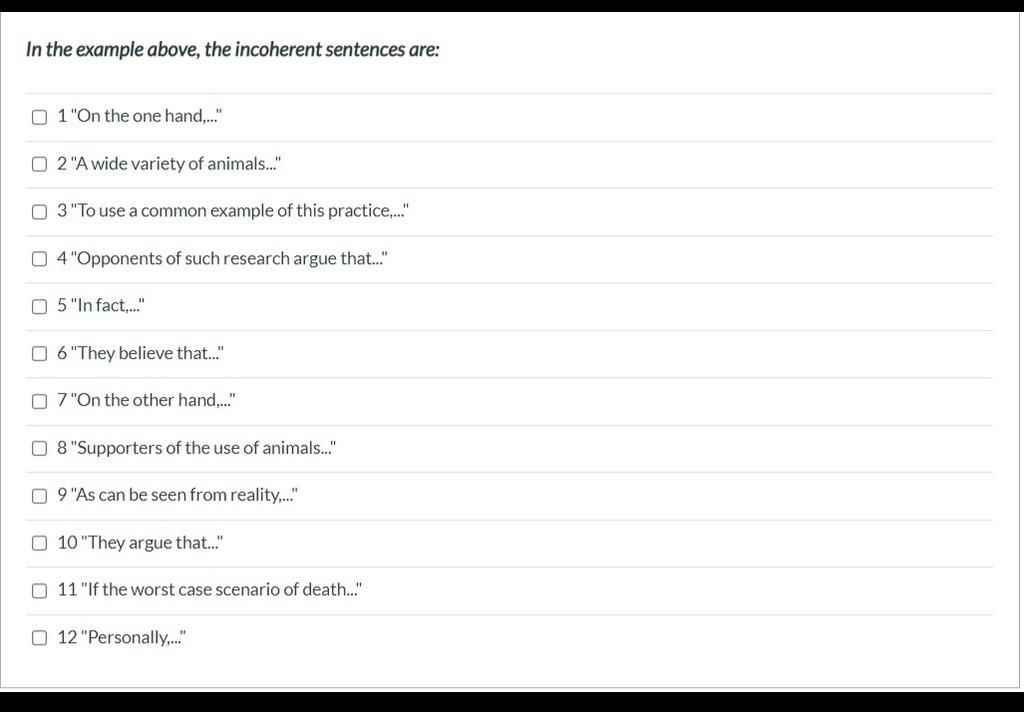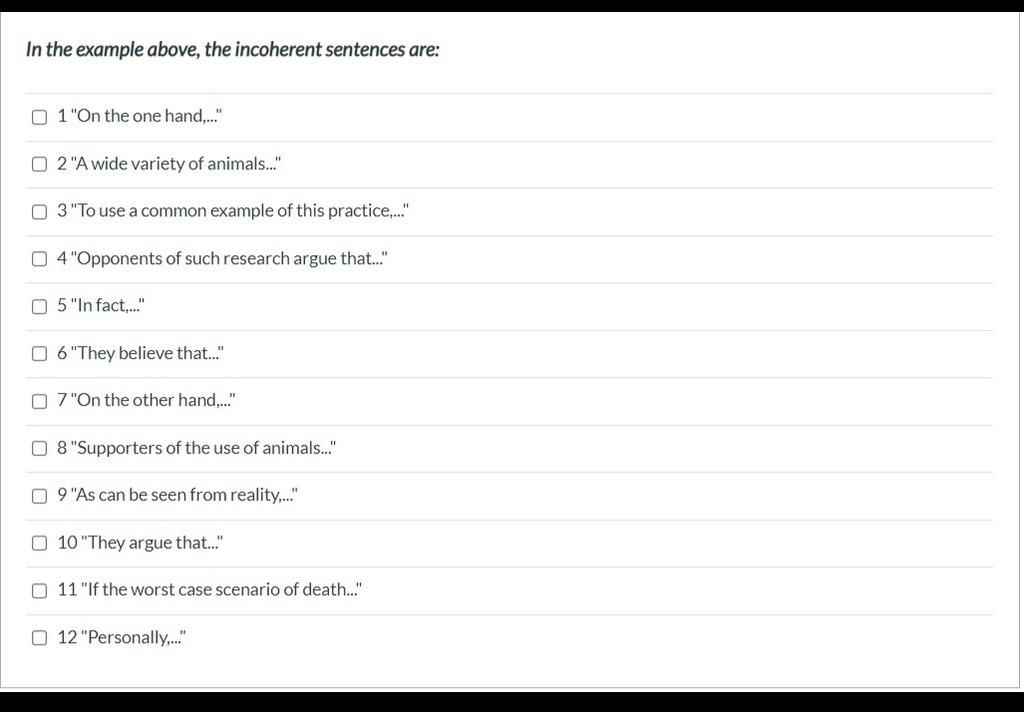 helppppppppppp
helppppppppppp
find the incoherent sentences
[1] On the one hand, there are clear ethical arguments against animal experimentation. [2] A wide variety of animals is currently in use for laboratory tests, with the most common being mice or rats thanks to their short life span and high fertility rate. [3] To use a common example of this practice, laboratory mice may be given an illness so that the effectiveness of a new drug can be measured. [4] Opponents of such research argue that humans have no right to subject animals to this kind of trauma, and that the lives of all creatures should be respected. [5] In fact, animal right activists aren’t just the people you see holding up signs when you’re commuting to work in the morning, and they are certainly not violent protestors who burn down lab buildings with the animals inside.
--
[6] They believe that the benefits to humans do not justify the suffering caused, and that scientists should use alternative methods of research.
[7] On the other hand, reliable alternatives to animal experimentation may not always be available. [8] Supporters of the use of animals in medical research believe that a certain amount of suffering on the part of mice or rats can be justified if human lives are saved. [9] As can be seen from reality, through gnawing, nest-building, and defecation, both rats and mice can cause a great deal of damage to the structure of people’s homes as well as eating and contaminating their food. [10] They argue that opponents of such research might feel differently if a member of their own families needed a medical treatment that had been developed through the use of animal experimentation. [11] If the worst case scenario of death unfortunately happens, the bereavement period is associated with elevated risk for the onset of multiple psychiatric disorders, consistently across the life course and coincident with the experience. [12] Personally, I agree with the banning of animal testing for non-medical products, but I feel that it may be a necessary evil where new drugs and medical procedures are concerned.
Hãy nhập câu hỏi của bạn vào đây, nếu là tài khoản VIP, bạn sẽ được ưu tiên trả lời.

[1] On the one hand, there are clear ethical arguments against animal experimentation. [2] A wide variety of animals is currently in use for laboratory tests, with the most common being mice or rats thanks to their short life span and high fertility rate. [3] To use a common example of this practice, laboratory mice may be given an illness so that the effectiveness of a new drug can be measured. [4] Opponents of such research argue that humans have no right to subject animals to this kind of trauma, and that the lives of all creatures should be respected. [5] In fact, animal right activists aren’t just the people you see holding up signs when you’re commuting to work in the morning, and they are certainly not violent protestors who burn down lab buildings with the animals inside.
--
[6] They believe that the benefits to humans do not justify the suffering caused, and that scientists should use alternative methods of research.
[7] On the other hand, reliable alternatives to animal experimentation may not always be available. [8] Supporters of the use of animals in medical research believe that a certain amount of suffering on the part of mice or rats can be justified if human lives are saved. [9] As can be seen from reality, through gnawing, nest-building, and defecation, both rats and mice can cause a great deal of damage to the structure of people’s homes as well as eating and contaminating their food. [10] They argue that opponents of such research might feel differently if a member of their own families needed a medical treatment that had been developed through the use of animal experimentation. [11] If the worst case scenario of death unfortunately happens, the bereavement period is associated with elevated risk for the onset of multiple psychiatric disorders, consistently across the life course and coincident with the experience. [12] Personally, I agree with the banning of animal testing for non-medical products, but I feel that it may be a necessary evil where new drugs and medical procedures are concerned.
3 câu trên là incoherent bởi vì:
- câu 1: Một mặt, có những lập luận đạo đức rõ ràng chống lại việc thử nghiệm trên động vật. - Đằng sau lại là những nội dung về thực trạng sử dụng động vật làm thí nghiệm.
- câu 5: Trên thực tế, các nhà hoạt động vì quyền động vật không chỉ là những người bạn nhìn thấy giơ biển báo khi đi làm vào buổi sáng và họ chắc chắn không phải là những người biểu tình bạo lực đốt phá các tòa nhà phòng thí nghiệm có động vật bên trong. - câu này rất không liên quan tới câu trước.
-câu 9: Thực tế có thể thấy, thông qua việc gặm nhấm, làm tổ và phóng uế, cả chuột và chuột đều có thể gây ra nhiều thiệt hại cho kết cấu nhà cửa của con người cũng như việc ăn và làm ô nhiễm thức ăn của họ. - những nội dung in đậm là key words của câu và nó chẳng liên quan tới vấn đề "justified" ở đằng trước.
Phản hồi đến em.

Đáp án : A
A: reason -> reasons
There are a number of + N (số nhiều)

Đáp án là C
“parasites, organisms that live on or in other living things and derive nutrients directly from them”- sinh vật sống trên hoặc trong các sinh vật khác và lấy được các chất dinh dưỡng trực tiếp từ chúng. “invertebrates - or creatures lacking a spinal column (including crustaceans, insects, and many different types of worms)” –động vật không xương sống- sinh vật thiếu cột sống ( bao gồm động vật giáp xác, côn trùng, và nhiều loại khác nhau của sâu”, vertebrates (creatures possessing a spinal column) – động vật có xương sống ( các sinh vật sở hữu 1 cột sống)-> loại trừ đáp án A, B, D.

Đáp án là C
Đoạn 2 “Certain fungi and even some kinds of bacteria secrete substances known as antibiotics… The same principle is used in defense against invaders in other groups of organisms” một số loại nấm và vi khuẩn tiết ra chất được gọi là kháng sinh… nguyên tắc tương tự với việc dùng để chống lại những kẻ xâm lăng từ các nhóm khác. -> chông lại nhóm sinh vật khác.

Đáp án là C
Individual= cá thể, vertebrate= động vật có xương sống, transplant = cấy ghép, sponges, worms and shellfish= bọt biển, sâu và một số hải sản có vỏ. Dòng 6 đoạn 3 “transplants of cells or fragments of tissues into an animal are accepted only if they come from genetically compatible” việc cấy ghép tế bào hoặc các mô vào động vật chỉ được chấp nhận khi nó tương thích về di truyền-> việc cấy ghép.

Mình nghĩ những câu đó là : 1, 5 , 10 và 12
thanks